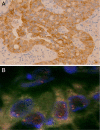Activity of EGFR-tyrosine kinase and ALK inhibitors for EML4-ALK-rearranged non-small-cell lung cancer harbored coexisting EGFR mutation
- PMID: 23714228
- PMCID: PMC3671182
- DOI: 10.1186/1471-2407-13-262
Activity of EGFR-tyrosine kinase and ALK inhibitors for EML4-ALK-rearranged non-small-cell lung cancer harbored coexisting EGFR mutation
Abstract
Background: The EML4-ALK (echinoderm microtubule-associated protein-like 4 gene and the anaplastic lymphoma kinase gene) fusion oncogene represents a novel molecular target in a small subset of non-small-cell lung cancers (NSCLCs). The EML4-ALK fusion gene occurs generally in NSCLC without mutations in epidermal growth factor receptor (EGFR) and KRAS.
Case presentation: We report that a case of EML4-ALK-positive NSCLC with EGFR mutation had a response of stable disease to both an EGFR tyrosine kinase inhibitor (EGFR-TKI) and ALK inhibitor.
Conclusions: We described the first clinical report of a patient with EML4-ALK-positive NSCLC with EGFR mutation that had a response of stable disease to both single-agent EGFR-TKI and ALK inhibitor. EML4-ALK translocation may be associated with resistance to EGFR-TKI, and EGFR signaling may contribute to resistance to ALK inhibitor in EML4-ALK-positive NSCLC.
Figures



References
Publication types
MeSH terms
Substances
LinkOut - more resources
Full Text Sources
Other Literature Sources
Medical
Research Materials
Miscellaneous

